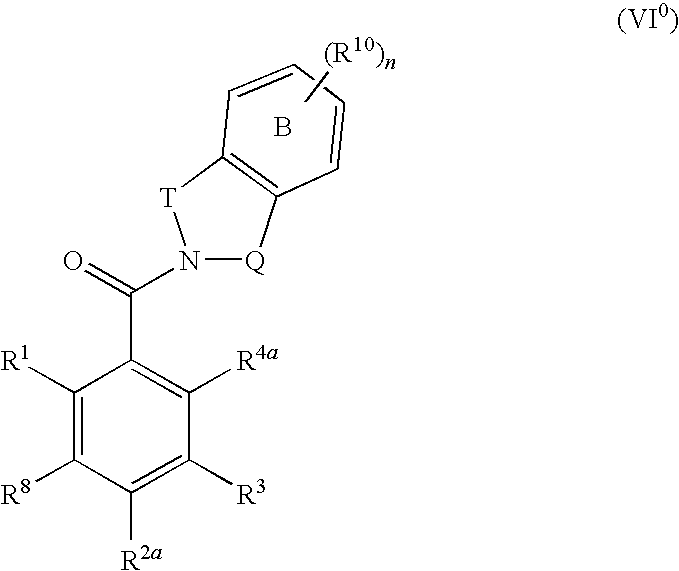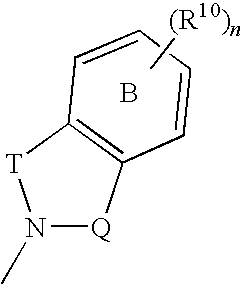Pharmaceutical compounds
a technology of pharmaceutical compounds and compounds, applied in the field of pharmaceutical compounds, can solve the problems of increasing the production of non-native or mutant proteins, increasing the requirement for chaperone systems, and g2/m arrest generally less well tolerated by cells, so as to prevent any pain from developing, reduce or even eliminate pain, and prevent existing pain from worsening
- Summary
- Abstract
- Description
- Claims
- Application Information
AI Technical Summary
Benefits of technology
Problems solved by technology
Method used
Image
Examples
preparation b8
Synthesis of 2,4-bis-benzyloxy-5-tert-butyl-benzoic acid
[0869]
[0870]1-(2,4-Bis-benzyloxy-5-tert-butyl-phenyl)-ethanone [prepared as per WO 2004 / 072051] (2.02 g, 5.2 mmol) was dissolved in 1,4-dioxane (30 ml), a solution of sodium hydroxide (2.08 g, 52.0 mmol) in water (30 ml) was added and the mixture was stirred and treated dropwise with bromine (0.8 ml, 15.6 mmol). The resulting mixture was stirred at room temperature for 16 hours. The 1,4-dioxane was removed in vacuo and the mixture acidified to pH 2 or below by the addition of 2M hydrochloric acid. The mixture was extracted with ethyl acetate, the organic layer was separated, the solvent removed in vacuo and the residue subjected to column chromatography on silica. Elution with 30% ethyl acetate in petroleum ether afforded 2,4-bis-benzyloxy-5-tert-butyl-benzoic acid (1.6 g, 79%) as a pale yellow oil. 1H NMR (DMSO-d6) 12.18 (1H, br s), 7.69 (1H, s), 7.52 (4H, t), 7.45-7.33 (6H, m), 6.93 (1H, s), 5.24 (2H, s), 5.23 (2H, s), 1.32 (...
preparation b9
Synthesis of 2,4-bis-benzyloxy-5-isopropenyl-benzoic acid
Alternative Synthesis
[0871]
Step 1: Synthesis of 2,4-bis-benzyloxy-5-bromo-benzoic acid benzyl ester
[0872]
[0873]To a 10 L jacketed vessel, fitted with a flange lid containing stirrer, thermometer and dropping funnel, was charged acetone (2.5 L) followed by 5-bromo-2,4-dihydroxybenzoic acid (100 g, 0.43 mol) and potassium carbonate (356 g, 2.58 mol). To the stirring mixture at ambient was added benzyl bromide (185 mL, 1.55 mol) at a rate of ˜20 ml / min. The mixture was heated at 60° C. for 18 h and then taken to 45° C. Water (1.5 L) was added and the mixture stirred for 30 min. The mixture was extracted with EtOAc (2×1 L) and the combined organic portions reduced in vacuo. To the residue was added Et2O (200 mL) and petroleum ether (1 L), the mixture stirred for 30 min and the solid formed collected by filtration and dried in vacuo to give the title compound (197.2 g) as a white solid.
Step 2: Synthesis of Potassium Isopropenyl Tri...
example 17
Synthesis of (5-chloro-1,3-dihydro-isoindol-2-yl)-(2,4-dihydroxy-5-isopropyl-phenyl)-methanone
[0975]
[0976]A solution of 2,4-bis-benzyloxy-5-isopropyl-benzoic acid (Preparation B10) (0.451 g, 1.2 mmol), EDC (0.276 mg, 1.44 mmol), HOAt (0.196 mg, 1.44 mmol), triethylamine (0.5 ml, 3.6 mmol) and 5-chloro-2,3-dihydro-1H-isoindole (0.187 g, 1.2 mmol) (Preparation C3) in DMF (5 ml) was stirred at room temperature for 16 hours, then evaporated under vacuum. The crude material was dissolved in ethyl acetate and extracted twice with saturated NaHCO3, organics washed with water three times, then evaporated under vacuum to give 0.5 g of 2,4-bis-benzyloxy-5-isopropyl-phenyl)-(5-chloro-1,3-dihydro-isoindol-2-yl)-methanone. MS: [M+H]+ 512
[0977]Boron trichloride (1M in DCM) was added dropwise to a solution of 2,4-bis-benzyloxy-5-isopropyl-phenyl)-(5-chloro-1,3-dihydro-isoindol-2-yl)-methanone (0.5 g, 0.97 mmol) in dry DCM (10 ml) at 0° C. under nitrogen, then stirred for at 0° C. for 1 hour, warme...
PUM
| Property | Measurement | Unit |
|---|---|---|
| Volume | aaaaa | aaaaa |
| Volume | aaaaa | aaaaa |
| Volume | aaaaa | aaaaa |
Abstract
Description
Claims
Application Information
 Login to View More
Login to View More - R&D
- Intellectual Property
- Life Sciences
- Materials
- Tech Scout
- Unparalleled Data Quality
- Higher Quality Content
- 60% Fewer Hallucinations
Browse by: Latest US Patents, China's latest patents, Technical Efficacy Thesaurus, Application Domain, Technology Topic, Popular Technical Reports.
© 2025 PatSnap. All rights reserved.Legal|Privacy policy|Modern Slavery Act Transparency Statement|Sitemap|About US| Contact US: help@patsnap.com



